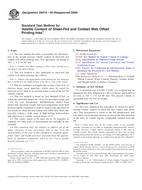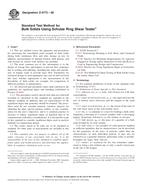We need your consent to use the individual data so that you can see information about your interests, among other things. Click "OK" to give your consent.
ASTM D6419-00(2009)
Standard Test Method for Volatile Content of Sheet-Fed and Coldset Web Offset Printing Inks
STANDARD published on 1.12.2009
The information about the standard:
Designation standards: ASTM D6419-00(2009)
Note: WITHDRAWN
Publication date standards: 1.12.2009
SKU: NS-35070
The number of pages: 3
Approximate weight : 9 g (0.02 lbs)
Country: American technical standard
Category: Technical standards ASTM
The category - similar standards:
Annotation of standard text ASTM D6419-00(2009) :
Keywords:
coldset web offset inks, coldset web offset ink vehicles, non-heatset web offset inks, non-heatset web offset vehicles, printing inks, printing ink vehicles, sheet-fed offset inks, sheet-fed offset ink vehicles, VOC in inks, volatile determination, volatiles, Nonheatset printing inks, Printing inks/vehicles, Volatile matter content, Web offset printing inks, ICS Number Code 59.080.01 (Textiles in general), 87.080 (Inks. Printing inks)
Additional information
| Significance and Use | ||||||||||
|
This test method is the procedure of choice for determining volatile content of sheet-fed and coldset web offset inks. This information is useful to the ink manufacturer and user and to environmental interests as part of the determination of the mass of volatile organic compounds emitted from the ink. Note 3—Since these inks do not contain water or any materials currently classified by US EPA as negligibly photochemically reactive (exempt solvents), volatile organic compound content is the same as volatile content. The volatile organic compounds in these inks are high boiling hydrocarbon oils which are, according to US EPA guidelines, 95 % retained in the printed substrate or oxidized into the ink film. Therefore, the mass of volatile organic compound emitted from the ink would be calculated as only 5 % of the volatile organic compound content of the ink as derived from the results of this test method. |
||||||||||
| 1. Scope | ||||||||||
|
1.1 This test method describes a procedure for determination of the weight percent volatile content of sheet-fed and coldset web offset printing inks. Test specimens are heated at 110° ± 1°C for 60 min. Note 1—Coldset web offset printing is often (also) referred to as non-heatset web offset printing. 1.2 This test method is also applicable to sheet-fed and coldset web offset printing ink vehicles. Note 2—Vehicle is the liquid portion of the printing ink. Any substance that is dissolved in the liquid portion of the ink is a part of the vehicle. 1.3 This test method is not applicable to ultra-violet (UV) or electron beam cured materials, which must be cured by exposure to UV light or an electron beam as part of the test for volatile content. 1.4 This test method is based on Test Method D2369, in which the allowable ranges are ±0.1g for specimen weight and ±5°C for oven temperature. Interlaboratory studies have shown that specimen weight and oven temperature must both be more tightly controlled in order to improve the precision of test results for sheet-fed and coldset web-offset inks. Such inks typically contain a wide range of high-boiling hydrocarbons and often have a volatile content below 25 %. 1.5 The values stated in SI units are to be regarded as standard. No other units of measurement are included in this standard. 1.6 This standard does not purport to address all of the safety concerns, if any, associated with its use. It is the responsibility of the user of this standard to establish appropriate safety and health practices and determine the applicability of regulatory limitations prior to use. For a specific hazard statement see 7.5.1. |
||||||||||
| 2. Referenced Documents | ||||||||||
|
Similar standards:
Historical
1.12.2012
Historical
1.6.2013
Historical
1.1.2011
Historical
1.1.2013
Historical
1.8.2008
Historical
1.10.2008
We recommend:
Technical standards updating
Do you want to make sure you use only the valid technical standards?
We can offer you a solution which will provide you a monthly overview concerning the updating of standards which you use.
Would you like to know more? Look at this page.



 ASTM D5426-12
ASTM D5426-12 ASTM D5548-13
ASTM D5548-13 ASTM D5591-04(2011)..
ASTM D5591-04(2011).. ASTM D5822-13
ASTM D5822-13 ASTM D629-08
ASTM D629-08 ASTM D6773-08
ASTM D6773-08
 Cookies
Cookies
